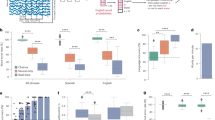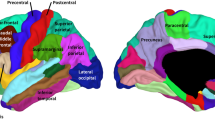Abstract
Foreign accent syndrome (FAS) is characterized by new onset speech that is perceived as foreign. Available data from acquired cases suggests focal brain damage in language and sensorimotor brain networks, but little remains known about abnormal functional connectivity in idiopathic cases of FAS without structural damage. Here, connectomic analyses were completed on three patients with idiopathic FAS to investigate unique functional connectivity abnormalities underlying accent change for the first time. Machine learning (ML)-based algorithms generated personalized brain connectomes based on a validated parcellation scheme from the Human Connectome Project (HCP). Diffusion tractography was performed on each patient to rule out structural fiber damage to the language system. Resting-state-fMRI was assessed with ML-based software to examine functional connectivity between individual parcellations within language and sensorimotor networks and subcortical structures. Functional connectivity matrices were created and compared against a dataset of 200 healthy subjects to identify abnormally connected parcellations. Three female patients (28–42 years) who presented with accent changes from Australian English to Irish (n = 2) or American English to British English (n = 1) demonstrated fully intact language system structural connectivity. All patients demonstrated functional connectivity anomalies within language and sensorimotor networks in numerous left frontal regions and between subcortical structures in one patient. Few commonalities in functional connectivity anomalies were identified between all three patients, specifically 3 internal-network parcellation pairs. No common inter-network functional connectivity anomalies were identified between all patients. The current study demonstrates specific language, and sensorimotor functional connectivity abnormalities can exist and be quantitatively shown in the absence of structural damage for future study.






Similar content being viewed by others
Data availability
All relevant data has been supplied in the current manuscript. Should the reader request additional data, the authors may be contacted for further information.
References
Miller N, Lowit A, O’Sullivan H (2006) What makes acquired foreign accent syndrome foreign? J Neurolinguistics 19:385–409. https://doi.org/10.1016/j.jneuroling.2006.03.005
Jonkers R, van der Scheer F, Gilbers D (2017) The common denominator in the perception of accents in cases with foreign accent syndrome. Aphasiology 31:1021–1043. https://doi.org/10.1080/02687038.2016.1232362
Chang EF, Niziolek CA, Knight RT, Nagarajan SS, Houde JF (2013) Human cortical sensorimotor network underlying feedback control of vocal pitch. Proc Natl Acad Sci 110(7):2653–2658. https://doi.org/10.1073/pnas.1216827110
Dichter BK, Breshears JD, Leonard MK, Chang EF (2018) The control of vocal pitch in human laryngeal motor cortex. Cell 174:21–31.e29. https://doi.org/10.1016/j.cell.2018.05.016
Poologaindran A, Lowe SR, Sughrue ME (2020) The cortical organization of language: distilling human connectome insights for supratentorial neurosurgery. J Neurosurg 1-8. https://doi.org/10.3171/2020.5.JNS191281
Saur D, Kreher BW, Schnell S, Kümmerer D, Kellmeyer P, Vry M-S, Umarova R, Musso M, Glauche V, Abel S, Huber W, Rijntjes M, Hennig J, Weiller C (2008) Ventral and dorsal pathways for language. Proc Natl Acad Sci 105:18035–18040. https://doi.org/10.1073/pnas.0805234105
Tomasino B, Marin D, Maieron M, Ius T, Budai R, Fabbro F, Skrap M (2013) Foreign accent syndrome: a multimodal mapping study. Cortex 49:18–39. https://doi.org/10.1016/j.cortex.2011.10.007
Higashiyama Y, Hamada T, Saito A, Morihara K, Okamoto M, Kimura K, Joki H, Kishida H, Doi H, Ueda N, Takeuchi H, Tanaka F (2021) Neural mechanisms of foreign accent syndrome: lesion and network analysis. Neuroimage Clin 31:102760. https://doi.org/10.1016/j.nicl.2021.102760
Glasser MF, Coalson TS, Robinson EC, Hacker CD, Harwell J, Yacoub E, Ugurbil K, Andersson J, Beckmann CF, Jenkinson M, Smith SM, Van Essen DC (2016) A multi-modal parcellation of human cerebral cortex. Nature 536:171–178. https://doi.org/10.1038/nature18933
Berthier ML, Ruiz A, Massone MI, Starkstein SE, Leiguarda RC (1991) Foreign accent syndrome: behavioural and anatomical findings in recovered and non-recovered patients. Aphasiology 5:129–147. https://doi.org/10.1080/02687039108249478
Luzzi S, Viticchi G, Piccirilli M, Fabi K, Pesallaccia M, Bartolini M, Provinciali L, Snowden JS (2008) Foreign accent syndrome as the initial sign of primary progressive aphasia. J Neurol Neurosurg Psychiatry 79:79–81. https://doi.org/10.1136/jnnp.2006.113365
Abel TJ, Hebb AO, Silbergeld DL (2009) Cortical stimulation mapping in a patient with foreign accent syndrome: case report. Clin Neurol Neurosurg 111:97–101. https://doi.org/10.1016/j.clineuro.2008.07.014
Keulen S, Mariën P, van Dun K, Bastiaanse R, Manto M, Verhoeven J (2017) The posterior fossa and foreign accent syndrome: report of two new cases and review of the literature. The Cerebellum 16:772–785. https://doi.org/10.1007/s12311-017-0849-6
Fridriksson J, Ryalls J, Rorden C, Morgan PS, George MS, Baylis GC (2005) Brain damage and cortical compensation in foreign accent syndrome. Neurocase 11:319–324. https://doi.org/10.1080/13554790591006302
Briggs RG, Allan PG, Poologaindran A, Dadario NB, Young IM, Ahsan SA, Teo C, Sughrue ME (2021) The frontal aslant tract and supplementary motor area syndrome: moving towards a connectomic initiation axis. Cancers 13(5):1116. https://doi.org/10.3390/cancers13051116
Keulen S, Verhoeven J, De Witte E, De Page L, Bastiaanse R, Mariën P (2016) Foreign accent syndrome as a psychogenic disorder: a review. Front Hum Neurosci 10:168. https://doi.org/10.3389/fnhum.2016.00168
Dadario NB, Brahimaj B, Yeung J, Sughrue ME (2021) Reducing the cognitive footprint of brain tumor surgery. Front Neurol 12:711646
Dadario NB, Sughrue ME (2022) Should neurosurgeons try to preserve non-traditional brain networks? A systematic review of the neuroscientific evidence. J Pers Med 12:587
Ren H, Zhu J, Su X, Chen S, Zeng S, Lan X, Zou L-Y, Sughrue ME, Guo Y (2020) Application of structural and functional connectome mismatch for classification and individualized therapy in Alzheimer disease. Front Public Health 8:584430–584430. https://doi.org/10.3389/fpubh.2020.584430
Doyen S, Nicholas P, Poologaindran A, Crawford L, Young IM, Romero-Garcia R, Sughrue ME (2021) Connectivity-based parcellation of normal and anatomically distorted human cerebral cortex. Hum Brain Mapp 43(4):1358–1369
Behzadi Y, Restom K, Liau J, Liu TT (2007) A component based noise correction method (CompCor) for BOLD and perfusion based fMRI. Neuroimage 37:90–101. https://doi.org/10.1016/j.neuroimage.2007.04.042
Briggs RG, Tanglay O, Dadario NB, Young IM, Fonseka RD, Hormovas J, Dhanaraj V, Lin YH, Kim SJ, Bouvette A, Chakraborty AR, Milligan TM, Abraham CJ, Anderson CD, O'Donoghue DL, Sughrue ME (2021) The unique fiber anatomy of middle temporal gyrus default mode connectivity. Oper Neurosurg 21:E8–E14. https://doi.org/10.1093/ons/opab109
Moreno-Torres I, Berthier ML, Mar Cid M, Green C, Gutiérrez A, García-Casares N, Froudist Walsh S, Nabrozidis A, Sidorova J, Dávila G, Carnero-Pardo C (2013) Foreign accent syndrome: a multimodal evaluation in the search of neuroscience-driven treatments. Neuropsychologia 51:520–537. https://doi.org/10.1016/j.neuropsychologia.2012.11.010
Milton CK, Dhanaraj V, Young IA-O, Taylor HM, Nicholas PJ, Briggs RG, Bai MA-O, Fonseka RD, Hormovas J, Lin YH, Tanglay OA-O, Conner AK, Glenn CA, Teo C, Doyen S, Sughrue MA-O (2021) Parcellation-based anatomic model of the semantic network. Brain Behav 11(4):e02065
Sandhu Z, Tanglay O, Young IM, Briggs RG, Bai MY, Larsen ML, Conner AK, Dhanaraj V, Lin Y-H, Hormovas J, Fonseka RD, Glenn CA, Sughrue ME (2021) Parcellation-based anatomic modeling of the default mode network. Brain Behav 11:e01976. https://doi.org/10.1002/brb3.1976
Akiki TJ, Abdallah CG (2019) Determining the hierarchical architecture of the human brain using subject-level clustering of functional networks. Sci Rep 9:19290. https://doi.org/10.1038/s41598-019-55738-y
Shahab QS, Young IM, Dadario NB, Tanglay O, Nicholas PJ, Lin Y-H, Fonseka RD, Yeung JT, Bai MY, Teo C (2022) A connectivity model of the anatomic substrates underlying Gerstmann syndrome. Brain commun 4(3):fcac140
Dadario NB, Brahimaj B, Yeung J, Sughrue ME (2021) Reducing the cognitive footprint of brain tumor surgery. Front Neurol 12:711646. https://doi.org/10.3389/fneur.2021.711646
Dadario NB, Sughrue ME (2022) Should neurosurgeons try to preserve non-traditional brain networks? A systematic review of the neuroscientific evidence. J Pers Med 12(4):587. https://doi.org/10.3390/jpm12040587
Berthier M, Dávila G, Moreno-Torres I, Beltrán-Corbellini Á, Santana-Moreno D, Torres-Prioris MJ, Massone MI, Cruces R, Roé Vellvé N, Thurnhofer-Hemsi K (2015) Loss of regional accent after damage to the speech production network. Front Hum Neurosci 9:610. https://doi.org/10.3389/fnhum.2015.00610
Sakurai Y, Itoh K, Sai K, Lee S, Abe S, Terao Y, Mannen T (2015) Impaired laryngeal voice production in a patient with foreign accent syndrome. Neurocase 21:289–298. https://doi.org/10.1080/13554794.2014.892622
Chang EF, Kurteff G, Andrews JP, Briggs RG, Conner AK, Battiste JD, Sughrue ME (2020) Pure apraxia of speech after resection based in the posterior middle frontal gyrus. Neurosurgery 87:E383–E389. https://doi.org/10.1093/neuros/nyaa002
Hickok G, Houde J, Rong F (2011) Sensorimotor integration in speech processing: computational basis and neural organization. Neuron 69:407–422. https://doi.org/10.1016/j.neuron.2011.01.019
Sheets JR, Briggs RG, Young IM, Bai MY, Lin YH, Poologaindran A, Conner AK, O'Neal CM, Baker CM, Glenn CA, Sughrue ME (2021) Parcellation-based modeling of the supplementary motor area. J Neurol Sci 421:117322. https://doi.org/10.1016/j.jns.2021.117322
Kumral E, Evyapan D, Balkir K (1999) Acute caudate vascular lesions. Stroke 30:100–108. https://doi.org/10.1161/01.STR.30.1.100
Berthier ML, Roé-Vellvé N, Moreno-Torres I, Falcon C, Thurnhofer-Hemsi K, Paredes-Pacheco J, Torres-Prioris MJ, De-Torres I, Alfaro F, Gutiérrez-Cardo AL, Baquero M, Ruiz-Cruces R, Dávila G (2016) Mild developmental foreign accent syndrome and psychiatric comorbidity: altered white matter integrity in speech and emotion regulation networks. Front Hum Neurosci 10:399. https://doi.org/10.3389/fnhum.2016.00399
Keulen S, Verhoeven J, De Page L, Jonkers R, Bastiaanse R, Mariën P (2016) Psychogenic foreign accent syndrome: a new case. Front Hum Neurosci 10:143. https://doi.org/10.3389/fnhum.2016.00143
Poulin S, Macoir J, Paquet N, Fossard M, Gagnon L (2007) Psychogenic or neurogenic origin of agrammatism and foreign accent syndrome in a bipolar patient: a case report. Ann Gen Psychiatry 6:1. https://doi.org/10.1186/1744-859X-6-1
Espay AJ, Aybek S, Carson A, Edwards MJ, Goldstein LH, Hallett M, LaFaver K, LaFrance WC Jr, Lang AE, Nicholson T, Nielsen G, Reuber M, Voon V, Stone J, Morgante F (2018) Current concepts in diagnosis and treatment of functional neurological disorders. JAMA Neurol 75:1132–1141. https://doi.org/10.1001/jamaneurol.2018.1264
Weber S, Heim S, Richiardi J, Van De Ville D, Serranova T, Jech R, Marapin RS, Tijssen MAJ, Aybek S (2022) Multi-centre classification of functional neurological disorders based on resting-state functional connectivity. Neuroimage Clin 35:103090. https://doi.org/10.1016/j.nicl.2022.103090
Young IM, Dadario NB, Tanglay O, Chen E, Cook B, Taylor HM, Crawford L, Yeung JT, Nicholas PJ, Doyen S, Sughrue ME (2023) Connectivity model of the anatomic substrates and network abnormalities in major depressive disorder: a coordinate meta-analysis of resting-state functional connectivity. J Affect Disord 11:100478. https://doi.org/10.1016/j.jadr.2023.100478
Author information
Authors and Affiliations
Contributions
Conceptualization: Michael Sughrue and Jonathan Sherman; methodology: Michael Sughrue; formal analysis and investigation: Michael Sughrue, Isabella Young, and Nicholas Dadario; writing — original draft preparation: Nicholas Dadario; writing — review and editing: Nicholas Dadario, Keaton Piper, Isabella Young, Jonathan Sherman, and Michael Sughrue; resources: Michael Sughrue and Jonathan Sherman; supervision: Michael Sughrue; figures and tables; Keaton Piper and Nicholas Dadario
Corresponding author
Ethics declarations
Ethical approval
All patients provided informed consent to study participation and image publication.
Conflict of interest
Michael Sughrue is the Chief Medical Officer and co-founder of Omniscient Neurotechnology. Isabella Young is an employee of Omniscient Neurotechnology. Products related to this company were only discussed as needed for statistical analyses in the current paper using the Quicktome software. No other authors report any conflict of interest.
Additional information
Publisher’s note
Springer Nature remains neutral with regard to jurisdictional claims in published maps and institutional affiliations.
Supplementary information
Supplementary file 1
Supplementary material have been provided detailing expanded methodology and results on recently reported coordinates for acquired cases of foreign accent syndrome in comparison with results presented in the current manuscript. (DOCX 38 kb)
Rights and permissions
Springer Nature or its licensor (e.g. a society or other partner) holds exclusive rights to this article under a publishing agreement with the author(s) or other rightsholder(s); author self-archiving of the accepted manuscript version of this article is solely governed by the terms of such publishing agreement and applicable law.
About this article
Cite this article
Dadario, N.B., Piper, K., Young, I.M. et al. Functional connectivity reveals different brain networks underlying the idiopathic foreign accent syndrome. Neurol Sci 44, 3087–3097 (2023). https://doi.org/10.1007/s10072-023-06762-4
Received:
Accepted:
Published:
Issue Date:
DOI: https://doi.org/10.1007/s10072-023-06762-4




